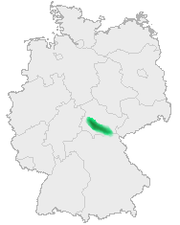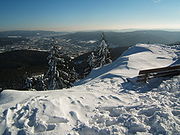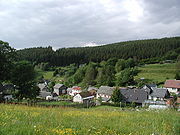
Thuringian Forest
Encyclopedia

Germany
Germany , officially the Federal Republic of Germany , is a federal parliamentary republic in Europe. The country consists of 16 states while the capital and largest city is Berlin. Germany covers an area of 357,021 km2 and has a largely temperate seasonal climate...
state of Thuringia
Thuringia
The Free State of Thuringia is a state of Germany, located in the central part of the country.It has an area of and 2.29 million inhabitants, making it the sixth smallest by area and the fifth smallest by population of Germany's sixteen states....
. It is about 120 km (74.6 mi) long and 35 km (21.7 mi) wide. The highest elevation is the Großer Beerberg
Großer Beerberg
The Grosser Beerberg is a mountain located in the Thuringian Forest, Germany and the highest point in Thuringia. The nearest town is Suhl, in Ilm-Kreis....
, 982 m (3,222 ft).
The Rennsteig
Rennsteig
The Rennsteig is a ridge walk as well as an historical boundary path in the Thuringian Forest, Thuringian Highland and Franconian Forest in central Germany....
(sometimes called Rennweg) is an ancient path following its summits along the main ridge. It is now a famous hiking path and it marks the traditional boundary between the hill
Hill
A hill is a landform that extends above the surrounding terrain. Hills often have a distinct summit, although in areas with scarp/dip topography a hill may refer to a particular section of flat terrain without a massive summit A hill is a landform that extends above the surrounding terrain. Hills...
s-dominated terrain of central Germany and the more rugged terrain characteristic of southern Germany, the boundary between central/north Thuringia
Thuringia
The Free State of Thuringia is a state of Germany, located in the central part of the country.It has an area of and 2.29 million inhabitants, making it the sixth smallest by area and the fifth smallest by population of Germany's sixteen states....
and Franconia
Franconia
Franconia is a region of Germany comprising the northern parts of the modern state of Bavaria, a small part of southern Thuringia, and a region in northeastern Baden-Württemberg called Tauberfranken...
. Dialects and traditional customs and costumes are different on either side of the Rennsteig. The Rennsteig is also the subject of the song Rennsteiglied, the unofficial hymn
Hymn
A hymn is a type of song, usually religious, specifically written for the purpose of praise, adoration or prayer, and typically addressed to a deity or deities, or to a prominent figure or personification...
of Thuringia.
The Thuringian Forest is famous for Wartburg Castle
Wartburg Castle
The Wartburg is a castle situated on a 1230-foot precipice to the southwest of, and overlooking the town of Eisenach, in the state of Thuringia, Germany...
outside Eisenach
Eisenach
Eisenach is a city in Thuringia, Germany. It is situated between the northern foothills of the Thuringian Forest and the Hainich National Park. Its population in 2006 was 43,626.-History:...
(where Martin Luther
Martin Luther
Martin Luther was a German priest, professor of theology and iconic figure of the Protestant Reformation. He strongly disputed the claim that freedom from God's punishment for sin could be purchased with money. He confronted indulgence salesman Johann Tetzel with his Ninety-Five Theses in 1517...
stayed for some time in exile) and year round tourism, including many winter sport
Winter sport
A winter sport is a sport which is played on snow or ice. Most such sports are variations of skiing, ice skating and sledding. Traditionally such sports were only played in cold areas during winter, but artificial snow and ice allow more flexibility...
s resorts.
Geologically, the Thuringian Forest is defined by a belt of strongly uplifted and deformed metamorphic
Metamorphic rock
Metamorphic rock is the transformation of an existing rock type, the protolith, in a process called metamorphism, which means "change in form". The protolith is subjected to heat and pressure causing profound physical and/or chemical change...
and igneous rock
Igneous rock
Igneous rock is one of the three main rock types, the others being sedimentary and metamorphic rock. Igneous rock is formed through the cooling and solidification of magma or lava...
that divides the relatively flat sedimentary plains of the Thüringer Becken (to the northeast) from similar rock formations in the valley of the Werra
Werra
The Werra is a river in central Germany, the right-source river of the Weser. The Werra has its source near Eisfeld in southern Thuringia. After 293 km the Werra joins the river Fulda in the town of Hann. Münden, forming the Weser....
(to the southwest). The Schwarza River
Schwarza River (Saale)
The Schwarza is a left tributary of the Saale in Thuringia, Germany, and 53 km long. Its source is in the Thuringian Forest, near Neuhaus am Rennweg. It flows into the Saale in Rudolstadt. Other towns on the Schwarza are Schwarzburg and Bad Blankenburg. It has 50 tributaries, the largest being the...
, following the axis of the Schwarzburg
Schwarzburg
Schwarzburg is a municipality in the valley of the Schwarza in the district Saalfeld-Rudolstadt in Thuringia, Germany.First mentioned in 1071 as Swartzinburg. The castle was from the 12th century the seat of the Counts of Schwarzburg...
anticline
Anticline
In structural geology, an anticline is a fold that is convex up and has its oldest beds at its core. The term is not to be confused with antiform, which is a purely descriptive term for any fold that is convex up. Therefore if age relationships In structural geology, an anticline is a fold that is...
(Schwarzburger Sattel), divides the Thuringinan Forest from the slate hills of Thuringia and Franconia, to the southeast. Ore deposits associated with this upthrust have been of significant historical importance in the development of the region, for example, in Suhl
Suhl
- Geography :Suhl sits on the south edge of the Suhler Scholle, an upthrust granite complex that is streaked by numerous dikes. This is part of the Ruhla-Schleusingen Horst that defines the southwest side of the Thuringian Forest...
and Ilmenau
Ilmenau
Ilmenau is a town located in the district of Ilm-Kreis, Thuringia, Germany.Ilmenau is situated in the valley of the Ilm river, at an altitude of 431 metres above sea level, and is the biggest town in Ilm-Kreis district, with 6,200 students studying at the Technische Universität Ilmenau. The...
.


Tabarz-Oberhof Thuringian Forest
The B 247 from LuisenthalLuisenthal
Luisenthal is a municipality in the district of Gotha, in Thuringia, Germany....
via Oberhof and Zella-Mehlis
Zella-Mehlis
Zella-Mehlis is a town in the Schmalkalden-Meiningen district, in Thuringia, Germany. It is situated in the Thuringian Forest, 5 km north of Suhl, and 20 km east of Meiningen. The town of Zella-Mehlis is the site of the original Walther arms weapons factory. It remained there until the...
to Suhl
Suhl
- Geography :Suhl sits on the south edge of the Suhler Scholle, an upthrust granite complex that is streaked by numerous dikes. This is part of the Ruhla-Schleusingen Horst that defines the southwest side of the Thuringian Forest...
, which follows the Ohra
Ohra (river)
Ohra is a river of Thuringia, Germany....
to the north, a section along the Lichtenau
Lichtenau (river)
Lichtenau is a river of Thuringia, Germany.-See also:*List of rivers of Thuringia...
to the south and finally the lower reaches of the Mühlwasser, together with the good 10 km long L 1028 road that runs parallel to it to the northwest separates this natural sub-division of the Thuringian Forest from the rest. Apart from the south, this region is hardly dissected by any public roads and is only populated in the south – in the villages of Schnellbach and Struth-Helmershof in the municipality of Floh-Seligenthal
Floh-Seligenthal
Floh-Seligenthal is a municipality in the district Schmalkalden-Meiningen, in Thuringia, Germany....
, the Rotterode
Rotterode
Rotterode is a municipality in the district Schmalkalden-Meiningen, in Thuringia, Germany....
, Unterschönau
Unterschönau
Unterschönau is a municipality in the district Schmalkalden-Meiningen, in Thuringia, Germany....
and Oberschönau
Oberschönau
Oberschönau is a municipality in the district Schmalkalden-Meiningen, in Thuringia, Germany....
suburbs of Steinbach-Hallenberg
Steinbach-Hallenberg
Steinbach-Hallenberg is a town in the Schmalkalden-Meiningen district, in Thuringia, Germany. It is situated in the Thuringian Forest, 8 km east of Schmalkalden, and 13 km northwest of Suhl.-References:-External links:*...
and the town of Zella-Mehlis.
The Elbe-Weser watershed, accompanied by the Rennsteig reaches heights of around at several places southwest to west of Oberhof, but does not really form any individual mountains and has very much the character of a mountain crest. By contrast, the Großer Hermannsberg und Ruppberg (see below) that rise to the southwest of the ridge are better known and popular tourist destinations. To the northeast, where the terrain gradually flattens out, are two of the 3 largest reservoirs in the Thuringian Forest (see below). The best known rock formation in the mountain range, the Falkenstein
Falkenstein (Thuringia)
The Falkenstein lies southeast of the small town of Tambach-Dietharz in Schmalwasser bottom and is the most important rock formation in the Thuringian Forest in central Germany. It consists of porphyry . On the valley side the crags are high...
, is also found in this area.
Rivers and lakes
The northeastern flank of the mountains is drained by right tributaries of the Apfelstädt, especially the Schmalwasser, and left tributaries of the OhraOhra (river)
Ohra is a river of Thuringia, Germany....
, notably the Kernwasser, via the (Apfelstädt,) Gera and Unstrut
Unstrut
The Unstrut is a river in Germany and a left tributary of the Saale. It originates in northern Thuringia near Dingelstädt and its catchment area is the whole of the Thuringian Basin...
into the Saale
Saale
The Saale, also known as the Saxon Saale and Thuringian Saale , is a river in Germany and a left-bank tributary of the Elbe. It is not to be confused with the smaller Franconian Saale, a right-bank tributary of the Main, or the Saale in Lower Saxony, a tributary of the Leine.-Course:The Saale...
. The Apfelstädt is impounded by the Tambarz-Dietharz Dam into a small lake and the Schmalwasser and Ohra by the Schmalwasser and Ohra Dams into larger reservoirs.
The south is drained by the Asbach which flows via the Stille
Stille (river)
Stille is a river of Thuringia, Germany.-See also:*List of rivers of Thuringia...
into the Schmalkalde
Schmalkalde
Schmalkalde is a river of Thuringia, Germany.-See also:*List of rivers of Thuringia...
and, from the Fächer der Hasel, the rivers and streams of the Schwarza
Schwarza (Hasel)
Schwarza is a river of Thuringia, Germany....
, Häselbach, Lichtenau
Lichtenau (river)
Lichtenau is a river of Thuringia, Germany.-See also:*List of rivers of Thuringia...
and Bach aus Albrechts into the Werra
Werra
The Werra is a river in central Germany, the right-source river of the Weser. The Werra has its source near Eisfeld in southern Thuringia. After 293 km the Werra joins the river Fulda in the town of Hann. Münden, forming the Weser....
.
Mountains
- Schützenberg
- Greifenberg
- Gebrannter Stein
- Donnershauk
- Schmalkalder Loibe
- Großer Hermannsberg - Stadtberg Steinbach-HallenbergSteinbach-HallenbergSteinbach-Hallenberg is a town in the Schmalkalden-Meiningen district, in Thuringia, Germany. It is situated in the Thuringian Forest, 8 km east of Schmalkalden, and 13 km northwest of Suhl.-References:-External links:*...
s, AT - Ruppberg - Stadtberg (northwest) Zella-MehlisZella-MehlisZella-Mehlis is a town in the Schmalkalden-Meiningen district, in Thuringia, Germany. It is situated in the Thuringian Forest, 5 km north of Suhl, and 20 km east of Meiningen. The town of Zella-Mehlis is the site of the original Walther arms weapons factory. It remained there until the...
', AT - Großer Buchenberg]]
- Krämerod
- Schwarzer Kopf
- Siegelberg ' onMouseout='HidePop("43788")' href="/topics/Luisenthal">LuisenthalLuisenthalLuisenthal is a municipality in the district of Gotha, in Thuringia, Germany....
)
External links
- Thueringer-wald.de
- Thueringer-landschaften.de, a web page with many pictures of thuringian landscapes

